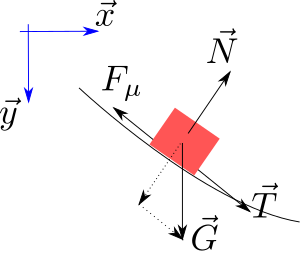Introduction To find the shape of the curve which the time is shortest possible. . .
We use WxMaxima to do the calculus part.
Theory Variational Calculus and Euler--Lagrange Equation The time from
P
a
{\displaystyle P_{a}}
P
b
{\displaystyle P_{b}}
t
=
∫
P
a
P
b
1
v
d
s
{\displaystyle t=\int _{P_{a}}^{P_{b}}{\frac {1}{v}}ds}
d
s
=
1
+
y
′
2
d
x
{\displaystyle ds={\sqrt {1+y'{^{2}}}}dx}
v
{\displaystyle v}
1
2
m
v
2
=
m
g
y
{\displaystyle {\frac {1}{2}}mv^{2}=mgy}
v
=
2
g
y
{\displaystyle v={\sqrt {2gy}}}
t
=
∫
P
a
P
b
1
+
y
′
2
2
g
y
d
x
=
∫
P
a
P
b
f
d
x
{\displaystyle t=\int _{P_{a}}^{P_{b}}{\sqrt {\frac {1+y'^{2}}{2gy}}}dx=\int _{P_{a}}^{P_{b}}fdx}
f
=
f
(
y
,
y
′
)
{\displaystyle f=f(y,y')}
According to the Euler--Lagrange differential equation the stationary value is to be found, if E-L equation
∂
f
∂
y
−
d
d
x
∂
f
∂
y
′
=
0
{\displaystyle {\frac {\partial f}{\partial y}}-{\frac {d}{dx}}{\frac {\partial f}{\partial y'}}=0}
No Friction Since
f
{\displaystyle f}
x
{\displaystyle x}
f
−
y
′
∂
f
∂
y
′
=
{\displaystyle f-y'{\frac {\partial f}{\partial y'}}=}
∂
f
∂
y
′
=
∂
∂
y
′
1
+
y
′
2
2
g
y
=
1
2
g
y
∂
∂
y
′
1
+
y
′
2
=
2
y
′
2
g
y
1
2
1
+
y
′
2
{\displaystyle {\frac {\partial f}{\partial y'}}={\frac {\partial }{\partial y'}}{\sqrt {\frac {1+y'^{2}}{2gy}}}={\frac {1}{\sqrt {2gy}}}{\frac {\partial }{\partial y'}}{\sqrt {1+y'^{2}}}={\frac {2y'}{\sqrt {2gy}}}{\frac {1}{2{\sqrt {1+y'^{2}}}}}}
Thus, we have
f
−
y
′
∂
f
∂
y
′
=
1
+
y
′
2
2
g
y
−
y
′
2
2
g
y
1
+
y
′
2
=
C
{\displaystyle f-y'{\frac {\partial f}{\partial y'}}={\sqrt {\frac {1+y'{^{2}}}{2gy}}}-{\frac {y'{^{2}}}{{\sqrt {2gy}}{\sqrt {1+y'^{2}}}}}=C}
1
+
y
′
2
2
g
y
(
1
+
y
′
2
)
−
y
′
2
2
g
y
1
+
y
′
2
=
1
2
g
y
(
1
+
y
′
2
)
=
C
{\displaystyle {\frac {1+y'{^{2}}}{\sqrt {2gy(1+y'{^{2}})}}}-{\frac {y'{^{2}}}{{\sqrt {2gy}}{\sqrt {1+y'^{2}}}}}={\frac {1}{\sqrt {2gy(1+y'{^{2}})}}}=C}
y
(
1
+
y
′
2
)
=
1
2
g
C
2
=
k
2
{\displaystyle y\left(1+y'^{2}\right)={\frac {1}{2gC^{2}}}=k^{2}}
x
=
1
2
k
2
(
θ
−
sin
θ
)
y
=
1
2
k
2
(
1
−
cos
θ
)
{\displaystyle {\begin{aligned}x&={\frac {1}{2}}k^{2}(\theta -\sin \theta )\\y&={\frac {1}{2}}k^{2}(1-\cos \theta )\end{aligned}}}
and is the equation of a cycloid.
The same
1 /2*m*v^2 = m*g*y;
v_sol : solve( energy, v) ;
v_sol : v_sol[ 2 ] ;
EL_f : rhs( sqrt( 1 +'diff(y,t)^2)/v_sol );
doof_dooyp : diff( EL_f, ' diff( y,t)) ;
EL: EL_f - ' diff( y,t) *doof_dooyp = C;
radcan( %) ;
EL_dy : solve( EL, y) ;
ode2( EL_dy[ 1 ] ^2,y,t) ;
but the ode2 solver cannot handle the nonlinear differential equation.
Rolling Ball: Angular momentum but no radius The rotational energy is
E
rot
=
1
2
I
ω
2
{\displaystyle E_{\text{rot}}={\frac {1}{2}}I\omega ^{2}}
v
=
ω
r
{\displaystyle v=\omega r}
E
rot
=
v
2
2
r
2
I
{\displaystyle E_{\text{rot}}={\frac {v^{2}}{2r^{2}}}I}
1 /2*m*v^2 + 1 /2*I*v^2/r^2= m*g*y;
. . .
gives
m
r
2
+
I
2
g
m
y
r
(
d
d
t
y
)
2
+
1
=
C
⇒
y
(
1
+
y
′
2
)
=
m
r
2
+
I
2
g
m
r
2
C
2
=
k
1
2
{\displaystyle {\begin{aligned}{\frac {\sqrt {m\,{{r}^{2}}+I}}{{\sqrt {2gmy}}r\,{\sqrt {{{\left({\frac {d}{dt}}y\right)}^{2}}+1}}}}=C&&\Rightarrow &&y(1+y'{^{2}})={\frac {mr^{2}+I}{2gmr^{2}C^{2}}}=k_{1}^{2}\end{aligned}}}
and thus only the constant
k
1
{\displaystyle k_{1}}
Friction The forces on the path. Actually the sliding particle is infinitemal small. The normal force follows the path, and thus is given by
T
→
=
d
x
d
s
x
→
+
d
y
d
s
y
→
{\displaystyle {\vec {T}}={\frac {dx}{ds}}{\vec {x}}+{\frac {dy}{ds}}{\vec {y}}}
N
→
=
−
d
y
d
s
x
→
+
d
x
d
s
y
→
{\displaystyle {\vec {N}}=-{\frac {dy}{ds}}{\vec {x}}+{\frac {dx}{ds}}{\vec {y}}}
The conservation of energy does not apply here, but we have Newton's Second Law,
F
→
=
m
d
v
→
d
t
{\displaystyle {\vec {F}}=m{\frac {d{\vec {v}}}{dt}}}
s
{\displaystyle s}
F
→
=
G
→
−
F
→
μ
=
m
g
d
y
d
s
−
μ
m
g
d
x
d
s
{\displaystyle {\begin{aligned}{\vec {F}}&={\vec {G}}-{\vec {F}}_{\mu }\\&=mg{\frac {dy}{ds}}-\mu mg{\frac {dx}{ds}}\end{aligned}}}
Clearly, for the left hand side of NII we have
m
d
v
d
t
=
m
v
d
v
d
s
=
m
1
2
d
v
2
d
s
{\displaystyle m{\frac {dv}{dt}}=mv{\frac {dv}{ds}}=m{\frac {1}{2}}{\frac {dv^{2}}{ds}}}
1
2
v
2
=
g
(
y
−
μ
x
)
v
=
2
g
(
y
−
μ
x
)
{\displaystyle {\begin{aligned}{\frac {1}{2}}v^{2}&=g(y-\mu x)\\v&={\sqrt {2g(y-\mu x)}}\end{aligned}}}
and
f
{\displaystyle f}
f
=
1
+
y
′
2
2
g
(
y
−
μ
x
)
{\displaystyle f={\sqrt {\frac {1+y'^{2}}{2g(y-\mu x)}}}}
Euler--Lagrange
2
(
y
(
t
)
−
μ
x
(
t
)
)
d
2
d
t
2
y
(
t
)
+
μ
(
d
d
t
x
(
t
)
)
(
d
d
t
y
(
t
)
)
3
+
(
d
d
t
y
(
t
)
)
2
+
μ
(
d
d
t
x
(
t
)
)
(
d
d
t
y
(
t
)
)
+
1
=
0
2
(
y
−
μ
x
)
d
2
y
d
t
2
+
(
1
+
(
d
y
d
t
)
2
)
(
1
+
μ
d
x
d
t
d
y
d
t
)
=
0
{\displaystyle {\begin{aligned}2\left(\operatorname {y} (t)-\mu \operatorname {x} (t)\right)\,{\frac {{d}^{2}}{d{{t}^{2}}}}\operatorname {y} (t)+\mu \left({\frac {d}{dt}}\operatorname {x} (t)\right)\,{{\left({\frac {d}{dt}}\operatorname {y} (t)\right)}^{3}}+\,{{\left({\frac {d}{dt}}\operatorname {y} (t)\right)}^{2}}+\mu \left({\frac {d}{dt}}\operatorname {x} (t)\right)\,\left({\frac {d}{dt}}\operatorname {y} (t)\right)+1=0\\2\left(y-\mu x\right)\,{\frac {d^{2}y}{dt^{2}}}+\left(1+\left({\frac {dy}{dt}}\right)^{2}\right)\left(1+\mu {\frac {dx}{dt}}{\frac {dy}{dt}}\right)=0\end{aligned}}}
Rolling Ball with radius References https://mathworld.wolfram.com/BrachistochroneProblem.html
https://physicscourses.colorado.edu/phys3210/phys3210_sp20/lecture/lec04-lagrangian-mechanics/
http://hades.mech.northwestern.edu/images/e/e6/Legeza-MechofSolids2010.pdf
https://www.tau.ac.il/~flaxer/edu/course/computerappl/exercise/Brachistochrone%20Curve.pdf
https://mate.uprh.edu/~urmaa/reports/brach.pdf
https://medium.com/cantors-paradise/the-famous-problem-of-the-brachistochrone-8b955d24bdf7
https://wiki.math.ntnu.no/_media/tma4180/2015v/calcvar.pdf
































